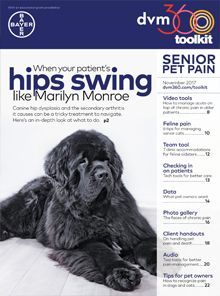
The senior pet pain toolkit
They don't stay puppies and kittens forever. Better management of pets' pain as they age allows the veterinary team to reinforce the human-animal bond and act as the trusted partner to pet parents. (With an educational grant by Bayer)
Click the preview image to download a PDF version of this toolkit. Your clients may wish that their pets would stay puppies and kittens forever. But of course, the unfortunate reality is that pets as pets age, their pain often increases. Which is why your team must continue to function as an important, trusted partner for pet parents whose older dogs and cats require love, attention and careful management of the painful conditions that crop up with age.
Pain control in senior pets is a rapidly developing field, and there's much to keep up on. That's where we come in. We've collected the most up-to-date information from experts in the field, the best communication tools to sure up your recommendations, and the latest client education tips to help get older pets the care they need.
Here are the tools:
Clinical updates
> Canine hip dysplasia and the secondary arthritis it causes can be a tricky treatment to navigate. Here's an in-depth look at what to do when your
> How to
> All those grumpy cats over the years? Maybe they were just in pain. Here are
> T
>
Communication + client education tools
> Client handouts for
>
Practice protocols
> Team handout:
> Every patient deserves a plan. Are you checking in with patients on a regular basis?
>
Data
>
> Painful realities:
Find more tools below ....
Clinical updates
> Pain management is everyone's job, but not everyone has the same role. Here's a look at what
> Craving structure for your clinic's pain strategy?
> All those grumpy cats over the years? Maybe they were just in pain. Here's
> So, yes, the profession has progressed light years when it comes to managing pets' pain, but do you know about all your options?
> A Great Dane
Communication + client education tools
> Video: Why
> You are your patient's advocate. Here are
>
> Client handout: The enigmatic ways
> Client handout:
>
> When "It hurts" meets "
Practice protocols
> Hey!!
> Pain management
> Refill, sure … but
Articles and tips
>
>
>
>
>
Your pain prevention tools
Audio clips
Listen as Drs. Ilona Rodan and Michael Petty discuss how to recognize pain in cats and how to succeed in the business of pain management.
>
>
>
>
>
Sample conversation tree
Use this sample script to help pet owners understand their pet's pain.
>
The dvm360 social media marketing kit for pain prevention
Use these pre-written
Video
These videos touch on pain issues for both cats and dogs, offering practical tips and ideas to pass on to clients who are dealing with pets in pain.
>
>
Team handout
Use the tips and ideas in this handout to ease the pain and strain of a veterinary visit for a pet.
>
More pain prevention tools ...
Articles and tips
>
>
>
Image quiz
Make sure you and your team know how to recognize subtle signs of acute, postoperative pain in cats.
>
Videos
Healing pet pain is a team effort. Watch these videos for tips and techniques that both clinicians and technicians can use.
>
>
>
Ready-to-use handouts
Take advantage of these handouts to reinforce your message about pain prevention to your clients and your team.
>
>
>
Take the next step
Newsletter
From exam room tips to practice management insights, get trusted veterinary news delivered straight to your inbox—subscribe to dvm360.







